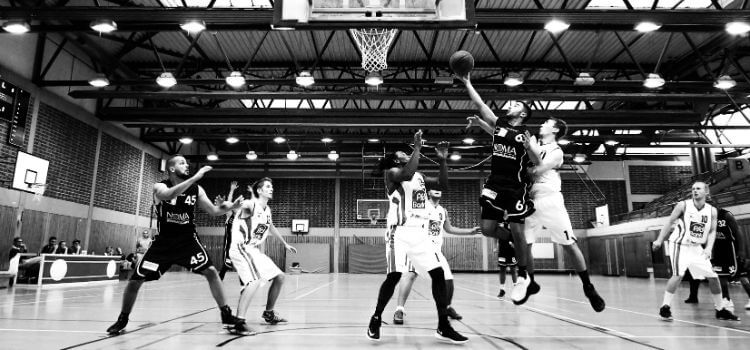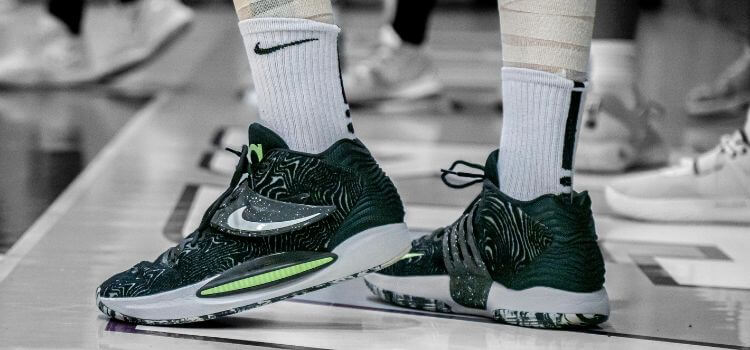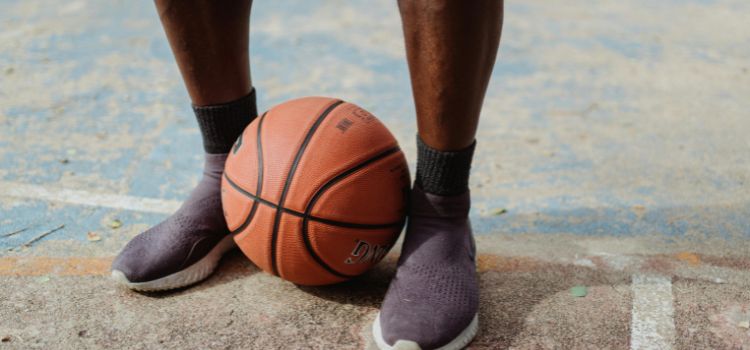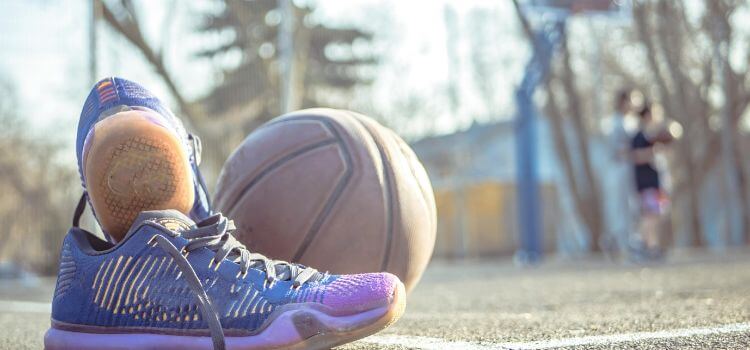Basketball shoes are exceptionally designed to be slip-resistant. They feature unique sole patterns and materials to enhance grip on the court.
Basketball shoes are a critical piece of athletic wear for players aiming for top performance on the court. These shoes boast specialized soles with herringbone patterns, pivot points for turns, and high-quality rubber compounds that collaborate to offer maximum traction.

This slip-resistant nature is vital in a sport that demands quick lateral movements, sudden stops, and explosive jumps. Not all basketball shoes are equal, so players should look for those with the best traction reviews to ensure safety and agility when playing. Quality basketball shoes balance durability, support, and this crucial slip-resistance feature to aid athletes in performing at their best while reducing the risk of slips and falls.
The Grip Game: How Basketball Shoes Aid Traction
Slick courts and quick moves need a shoe that sticks. Enter basketball shoes with their secret weapon: grip. These shoes help players turn, stop, and sprint without slipping. Let’s explore how these sneakers keep athletes on their feet and in the game.
Materials Matter: Rubber And Synthetic Soles
Basketball shoes need soles that can hold the court. Rubber and synthetic materials give these shoes their stickiness. Natural rubber offers excellent traction, while synthetic soles are durable and weather-resistant. Together, these materials make a sole that grips well and lasts long.
- Rubber: Soft and sticky for indoor courts.
- Synthetic: Tough for outdoor wear.
Tread Patterns: Design Dynamics For Court Contact
The bottom of a basketball shoe isn’t just flat. It has tread patterns—lines and shapes that touch the ground—key for control. Herringbone, which looks like zigzags or V-shapes, is a typical pattern. It helps players stop quickly and change direction. Other patterns may vary, each offering unique benefits.
| Tread Pattern | Advantages |
| The herringbone | is Great for multi-directional movement. |
| Circles or Curves | Smooth turns and spins. |
| Wavy Lines | Additional flexibility. |
Designers test these patterns to make sure they grip right. They help players make their moves without a second thought. That means more focus on the game and less worry about a slip.
From Hardwood To Asphalt: Versatility Of Basketball Footwear
From Hardwood to Asphalt: Versatility of Basketball Footwear – a topic that garners the attention of every hoop enthusiast. Players often tackle the question of traction and slip resistance. The answer isn’t a simple yes or no. It’s about the performance of basketball shoes across diverse playing surfaces.
Shoe Performance On Different Playing Surfaces
Each surface demands specific features from a shoe to ensure peak performance and safety. Let’s delve into the qualities basketball shoes offer for different courts.
- Hardwood Courts: These courts are predominantly indoor and require shoes with softer rubber outsoles. The sole patterns are designed for a smooth, polished surface, optimizing grip and minimizing slippage.
- Asphalt Courts: Asphalt is often rough and abrasive outdoors. Shoes for asphalt boast more rigid soles with deep grooves. They withstand the wear while still maintaining essential traction.
Transitioning From Indoor To Outdoor Courts
Basketball shoes must transition between indoor and outdoor environments. But do they retain their non-slip qualities on both fronts?
| Feature | Indoor Suitability | Outdoor Suitability |
| Material Durability | Focus on comfort and flexibility | Reinforced for resistance |
| Traction Pattern | Fine details for grip | Rugged for varied terrain |
| Sole Hardness | Softer for polished wood | Harder to prevent erosion |
Basketball shoes bridge the gap between indoor elegance and outdoor toughness. They provide necessary protection and grip. The crossover, though, often means a compromise. For avid players who frequently switch courts, consider having a dedicated pair for each setting.
Slip-resistance Technology In Basketball Shoes
Basketball demands swift, sudden moves on the court. Slip-resistance technology in Basketball Shoes ensures players can move with speed and precision. This tech keeps players safe from slips, supporting top performance. Let’s explore how these shoes stay grippy.
Advancements In Sole Engineering
Shoe soles are crucial for anti-slip action. Recent advancements keep players steady. Designers use patterns and shapes that grip the court better. These patterns are like tires on a car, tailored for the court’s surface. They turn quick moves into safe steps.
- Herringbone pattern – Classic, reliable grip
- Circle-based designs – Grab the court at any angle.
- Hexagonal layouts – Cutting-edge, multi-directional stickiness

Emerging Materials For Enhanced Friction
New materials are raising the bar for shoe friction. Manufacturers are mixing high-tech compounds that stick better to hardwood floors. These materials are also rigid and can withstand many games.
| Material | Benefits |
| Synthetic Rubber | – High friction – Durable |
| Advanced Polymers | – Grippy even on dusty courts – Long-lasting |
| Non-Marking Rubber | – Keeps floors clean – Strong grip |
These innovations work together for safer, sharper gameplay. Basketball shoes with these features let players focus on scoring, not slipping.
Signature Kicks: Athlete-endorsed Shoes And Their Traction Features
Attention all hoop fans and sneakerheads! Why can you stop on a dime like your favorite basketball superstar? It’s all in the shoes—specifically, those signature kicks designed with traction. These athlete-endorsed shoes aren’t just fashion statements; their soles are for superior grip. Let’s dive into how these sneakers help you cut and sprint without slipping on the court.
Star Power: How Pros Influence Shoe Design
Thanks to input from pro ballers, basketball shoes blend style with performance. Stars work with brands to create shoes that offer exceptional traction so you can play safely and effectively.
Breaking Down Popular Models’ Grip Traits
Popular models boast unique grip traits that set them apart. Let’s break them down:
| Shoe Model | Traction Pattern | Material | Performance Benefit |
| Air Zoom G.T. Cut | Circular wave | Rubber | Quick turns |
| Kyrie 7 | Multi-angle blade | Rubber | Agile movements |
| Curry Flow 8 | Organic herringbone | Foam compound | No-slip grip |
- Circular wave patterns offer a 360-degree grip for sudden changes in direction.
- Blade-like traction works best for lateral movements and crossovers.
- Herringbone designs provide a classic grip that’s reliable for all play styles.
Testing The Treads: Methods For Assessing Slip-resistance
Knowing if your shoes will keep you safe is essential if you love playing basketball. We should examine whether basketball shoes are slip-resistant.
Laboratory Versus Real-world Testing
To know if basketball shoes can stop slips, we must test them. We can do tests in two places: in a laboratory or where you play basketball. Let’s explore both:
- Laboratory Testing: Scientists use special machines to see how much a shoe can grip in a controlled place. This makes sure we test every shoe the same way.
- Real-world Testing: Athletes wear the boots and play their sport. They check that the shoes allow them to move fast without falling.

Standards And Ratings For Sports Footwear
Basketball shoes get scores to show how well they stick to the floor. These scores come from tests and rules that shoemakers must follow. Here are the two main parts:
- Standards: These are like rules for testing shoes. They tell you how to perform the tests and what numbers mean the shoes are safe.
- Ratings: After testing, shoes get a rating of good, better, or best. This tells us if the shoe can help stop slips.
When you buy basketball shoes, look for these scores to ensure they are safe and can help you play your best game.
Maintenance Tips: Maximizing Your Shoes’ Traction
It is crucial to maintain your basketball shoes for optimal traction. Proper care extends their life and performance. Let’s delve into how to keep your shoes boots and game-ready.
Proper Cleaning Techniques
Clean shoes mean better grip. Dirt and dust compromise shoe traction. Follow these steps to ensure your basketball shoes are slip-resistant:
- Remove excess dirt: Knock the soles together. Use a brush for stubborn dirt.
- Create a cleaning solution: Mix water with a small amount of mild soap.
- Gentle scrub: Use a soft-bristled brush. Clean the outsoles thoroughly.
- Wipe down: Use a wet cloth to remove soap and dirt.
- Air dry: Never use heat. Let your shoes dry at room temperature.
When To Replace: Recognizing Tread Wear
Over Time, shoe treads wear down, reducing traction. Know when to replace your basketball shoes:
| Sign | What to Do |
| Smooth soles | It’s Time for new shoes. Smooth soles mean less grip |
| Worn-out patterns | Check the tread pattern. If it’s fading, replace the shoes. |
| Uneven wear | Uneven soles can cause slips. Get a new pair. |
Basketball Shoes In Action: Player Experiences And Reviews
Discover the real-world performance of basketball shoes from those who know them best: the players. This section digs into firsthand accounts and reviews. Learn what makes a basketball shoe trusty on the court. Real athletes share their experiences, helping you choose the perfect pair.

Anecdotal Evidence From The Court
Players rely on their shoes for that critical grip during games. Here are snapshots of on-court experiences:
- Quick stops and starts: One varsity player mentioned his pair prevented slips during a buzzer-beater.
- Defensive shuffles: A professional pointed out that there was no loss of traction when guarding opponents.
- Jumping for rebounds: A weekend warrior praised his shoes for stable landings.
Comparing Brands Through Athlete Feedback
Top basketball brands are put to the test. Athletes weigh in on their experiences:
| Brand | Traction | Comfort | Durability |
| Nike | Excellent | Superb | High |
| Adidas | Great | Good | Varies |
| Under Armour | Good | Comfortable | Depends on model |
Feedback highlights the unique strengths of each brand, assisting buyers in their decisions.
The Future On Foot: Innovations In Slip-resistant Basketball Shoes
The Future on Foot: Innovations in Slip-resistant Basketball Shoes promise a game-changing experience for athletes around the globe. Gone are the days of sliding across the court due to poor traction. The latest technological advancements aim to enhance performance and increase safety, ensuring that each jump and pivot is as secure as possible.
Research And Development In Footwear Technology
Manufacturers continue to push the boundaries of footwear science. With new materials and designs, the focus remains on creating the most slip-resistant basketball shoes possible. Teams of engineers and athletes test and refine shoe prototypes in real-world scenarios. This intensive R&D ensures that the final products are at the pinnacle of grip and stability.
- Laboratory tests simulate harsh conditions.
- Field studies with real players give accurate results.
- Feedback loops guide the improvement process.
Anticipating Next-gen Basketball Shoes
The future of basketball shoes is brimming with potential. Innovators are exploring revolutionary materials like graphene and advanced polymers to offer unprecedented grip. They also investing in innovative technologies that adapt to movement patterns, providing optimal traction at every turn. These enhancements herald a new era for basketball footwear, where slip resistance and agility go hand in hand.
- Integration of intelligent sensors to monitor pressure.
- Use of adaptive materials that change with motion.
- Development of personalized shoe profiles for individual players.
Expect lighter, stronger, and more responsive basketball shoes as these technologies mature. Players will enjoy a level of stability and confidence on the court that they have never felt before. These advancements stand to redefine not just basketball footwear but the very nature of the game itself.
Frequently Asked Questions On Are Basketball Shoes Slip-resistant
Do Basketball Shoes Count As Slip-resistant?
Basketball shoes are only sometimes slip-resistant. While they provide grip on the court, their slip resistance varies by model and brand. Always check the shoe specifications for slip-resistance features.
How Do I Know If My Shoes Are Slip-resistant?
Check the sole for a tread pattern and rubber material, as these features enhance grip. Test the shoes on various surfaces to assess their traction. Look for shoes labeled “slip-resistant” for assured safety.
How Do I Make My Basketball Shoes Not Slip?
To prevent basketball shoes from slipping, regularly clean the soles, use a grip lotion, wear shoes with non-slip tread, select appropriate insoles, and keep courts clean and dry.
What Shoes Classify As Non-slip Shoes?
Non-slip shoes feature soles with particular tread patterns to increase traction. They resist sliding on wet or oily floors and are commonly used in kitchens, hospitals, and industrial workplaces.
Conclusion
In conclusion, the slip-resistance of basketball shoes is vital for players’ safety and performance. These specialized sneakers blend style with function, offering traction to maneuver swiftly on the court. Choose a pair that promises grip and comfort to excel in your game.
Remember, the right shoe can be a game-changer!
Related posts:
- Can Basketball Shoes Be Used For Running
- How Many Inches Do Basketball Shoes Add
- Are Volleyball Shoes & Basketball Shoes The Same
- Can You Wear Basketball Shoes Casually
- Are Basketball Shoes Good For Walking
- How Long Do Basketball Shoes Last
- How To Make Your Basketball Shoes Have More Grip
- Why Do Basketball Players Wipe Their Shoes
- Are Basketball Shoes Supposed To Be Tight
